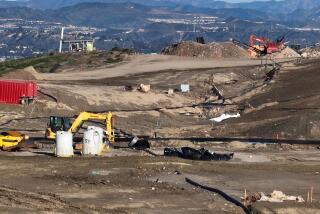1 Killed, Scores Ill in Uranium Plant Leak : Rupture of Cylinder Releases Radioactive Gas at Oklahoma Site
WEBBERS FALLS, Okla. — A tank containing highly toxic, radioactive gas ruptured at a uranium-processing plant Saturday, killing a worker and sickening scores of employees and residents, authorities said.
Eight employees of the Sequoyah Fuels Corp. plant who were initially exposed to the leak were taken to Sequoyah Memorial Hospital in Sallisaw immediately after the accident for treatment of exposure to the gas.
Of the 83 workers and residents who went to the hospital for treatment during the day, most of whom complained of chest pains. Officials said Saturday night that 29 of those people were admitted for observation and treatment of exposure.
‘A Real Madhouse’
“It’s a real madhouse down here with all these folks coming in,” hospital spokeswoman Bea Ford said.
Interstate 40 was closed for two hours after 14,000 pounds of slightly radioactive uranium hexafluoride gas floated into the air from the nuclear plant, officials said.
Plant worker James Harrison, 25, of Vian, Okla., died at Sparks Regional Medical Center in Fort Smith, Ark., about four hours after the accident.
Harrison suffered “toxic chemical exposure with hydrofluoric acid burns to the face and lungs,” a hospital spokeswoman said.
The plant purifies uranium for production of nuclear fuel rods and has 32 employees.
Area Sparsely Populated
The plant, owned by a subsidiary of the Oklahoma City-based Kerr-McGee Corp., is in a sparsely populated section about 40 miles west of Fort Smith.
It was evacuated after a 14-ton cylinder ruptured late in the morning but was back in operation by late afternoon, said Donna McFarland, spokeswoman for Kerr-McGee. She said she did not know how the cylinder broke.
Rick Pereles, another Kerr-McGee spokesman, said the container was being heated at the time.
‘Apparent Acid Exposure’
Dr. Michael Herndon, an emergency room physician at Sequoyah Memorial, said doctors treated Harrison and eight other plant employees immediately after the accident for “apparent hydrofluoric acid exposure.”
Exposure to the gas causes irritation to the eyes, skin and respiratory system, Herndon said.
Harrison and another patient were transferred to the Sparks Center. Of the seven other workers initially exposed to the leak, six were in stable condition, and one was released, Herndon said.
When released into the atmosphere, uranium hexaflouride gas breaks down into hydrogen flouride and low-level radioactive uranyl flouride particles, McFarland said. Hydrogen flouride and hydroflouric acid, its form in the atmosphere, also are highly toxic.
Residents to Be Examined
As a precaution, the remaining employees and residents living in the path of the cloud will be examined by doctors, officials said.
John Stauter, Kerr-McGee’s director of nuclear licensing, and civil defense officials said there did not appear to be any danger to the area surrounding the uranium purification plant. The nearest houses are a half-mile south of the plant.
A radiation survey will be conducted, McFarland said, but she explained that a preliminary survey indicated radioactivity in the area was at normal levels.
Authorities said the cloud dissipated in winds of more than 20 m.p.h. about two hours after the first report of the leak.
“The heavier uranyl fluoride particles settled out in the immediate area of the plant,” Stauter said. “A thorough radiation survey will be conducted; however, a preliminary survey indicated that radioactivity on the public highways in the area is at normal background levels.
“As a precautionary measure, all other employees at the plant today and all residents in the path of vapor dispersions will receive medical examinations at local health-care facilities.”
The state highway patrol said Interstate 40 was closed in eastern Oklahoma from Webbers Falls to Vian.
Used in Converting Ore
Nuclear Regulatory Commission spokesman Joe Fouchard said in Washington that the chemical is used to convert uranium ore into fuel for nuclear power plants. “It’s part of the conversion process leading to the enrichment of uranium,” he said.
More to Read
Sign up for Essential California
The most important California stories and recommendations in your inbox every morning.
You may occasionally receive promotional content from the Los Angeles Times.










